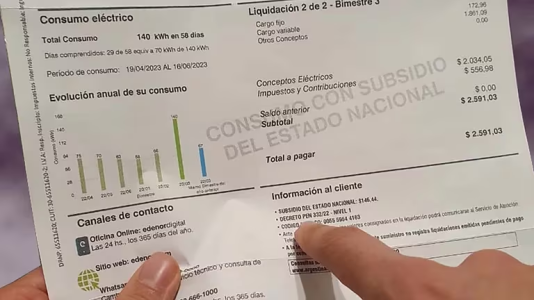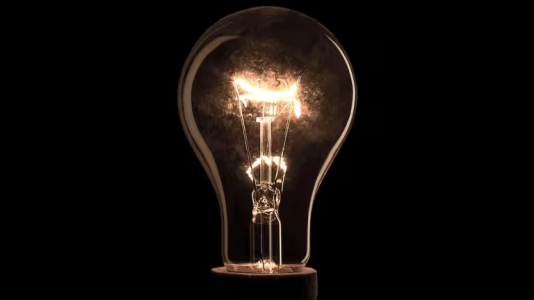Josh27
New member
The Government increased electricity rates up to 150% in the AMBA and there will be monthly updates from April - Infobae

Source:

 www.infobae.com
www.infobae.com
February 15, 2024
The new tariff tables will be in force for one year, until the review system for the five-year period is finalized.
By Agustin Maza

Higher-income users will receive higher-than-average increases.
The Government reported that starting this month there will be an increase of up to 150% in the electricity rates paid by high-income users , after announcing the new tables for the distributors of the Metropolitan Area of Buenos Aires (AMBA) that will be in force. during the next year. Low-income consumers (categorized as N2) will see an increase of around 70% and middle-income consumers (known as N3) around 65%, although for the latter universe if it exceeds 600 KW/h the jump will be in the 130 percent zone.
The new values will govern until the comprehensive tariff review pending for this five-year period (2024-2028) is completed, while from April a monthly adjustment mechanism based on inflation will be applied . Regarding this last point, the official intention is that there is no delay in real terms of the bills that consumers face with the aim of staying on the path of reducing subsidies that marks the fiscal balance roadmap that the Ministry set. of Economy.
The information was released this Thursday by the Ministry of Energy led by Eduardo Rodríguez Chirillo through an official statement. As detailed in the text, in absolute terms, “considering an average consumption of 380 KV/h per month, in the case of N1 users, a bill of $13,900 will be paid $34,332, which represents an increase of 150 percent.”

The Government wants to reduce energy subsidies by 0.5 points of GDP in 2024. (Grosby)
“In the case of N2 users, for the same level of consumption and period, it will go from $4,360 to $7,415, which represents an update of 70%; and in the case of N3, it will go from $4,783 to $7,850, equivalent to a difference of 65 percent. However, it should be noted that, in this class of users, if consumption exceeds 400 KW/h per month, if consumption reaches 600 KW/h the amount would go from $14,600 to $34,000, that is, a 130% difference in the tariff reconfiguration,” said Energía.
“In terms of relative percentage points (the comparison of the current values with those that prevailed until now) a single general increase cannot be indicated because, until now, there were different categories of users who paid different prices for the energy and power that the distributors acquired. in the Wholesale Electricity Market (MEM) ,” Energía explained.
Currently, the segmentation of subsidies contemplates three universes of users but determined by the Total Basic Basket (CBT) of Indec : Level 1 (high income) who pay full rate for having an income greater than 3.5 CBT ($2,089,881, 13), Level 2 (low income) with social rate and N3 (middle income) that maintain assistance up to a certain consumption (400 KW/h) and pay in full for the surplus.
As reported, the Government will advance in what they called a “normalization” process of the electricity sector based on three guidelines: “A) it will adopt measures to recompose the functioning of the Wholesale Market, so that the offer interacts freely and competitively with the demand; b) will proceed to reallocate subsidies to provide assistance to those with less purchasing power; c) promote and help high-consumption users to make responsible and efficient use of energy, through energy efficiency programs.”

The Government is preparing a new subsidy scheme to apply from May.
The virtual tariff freeze applied by the previous Government implied a greater transfer of subsidies that the new management seeks to correct. Obviously, in the short term this will translate into a hit to consumers' pockets.
By 2023, the volume of economic subsidies reached 2.1% of the Gross Domestic Product (GDP), with the energy sector contributing 1.6 percentage points, which represents approximately 9,683 million dollars, according to estimates made by the International Monetary Fund (IMF) and the consulting firm Economía & Energía. The objective has been set for 2024 to reduce these subsidies to 1.3% of GDP in general terms, and to 1.1% specifically in the energy field.
IMF experts , in the Staff Report , suggested that starting in February, tariff increases of more than 200% in electricity and 150% in gas should be implemented. However, the Government opts for a position of prudence, deciding to postpone any rate increase until after holding a new public hearing to establish the validity of the “Basic Energy Basket”, affecting the 70% of the population whose income does not They exceed 3.5 basic baskets.
With an eye on April-May, it is planned to introduce a new scheme that will replace the current segmentation, focusing subsidies on those households whose energy expenditure exceeds 10% of their income. In this way, state support would focus on the amount that exceeds said percentage, in order to alleviate the financial burden on consumers.

Source:

El Gobierno aumentó las tarifas de luz hasta 150% en el AMBA y habrá actualizaciones mensuales desde abril
Los nuevos cuadros tarifarios estarán vigentes durante un año, hasta que se finalice el sistema de revisión para el quinquenio
February 15, 2024
The new tariff tables will be in force for one year, until the review system for the five-year period is finalized.
By Agustin Maza

Higher-income users will receive higher-than-average increases.
The Government reported that starting this month there will be an increase of up to 150% in the electricity rates paid by high-income users , after announcing the new tables for the distributors of the Metropolitan Area of Buenos Aires (AMBA) that will be in force. during the next year. Low-income consumers (categorized as N2) will see an increase of around 70% and middle-income consumers (known as N3) around 65%, although for the latter universe if it exceeds 600 KW/h the jump will be in the 130 percent zone.
The new values will govern until the comprehensive tariff review pending for this five-year period (2024-2028) is completed, while from April a monthly adjustment mechanism based on inflation will be applied . Regarding this last point, the official intention is that there is no delay in real terms of the bills that consumers face with the aim of staying on the path of reducing subsidies that marks the fiscal balance roadmap that the Ministry set. of Economy.
The information was released this Thursday by the Ministry of Energy led by Eduardo Rodríguez Chirillo through an official statement. As detailed in the text, in absolute terms, “considering an average consumption of 380 KV/h per month, in the case of N1 users, a bill of $13,900 will be paid $34,332, which represents an increase of 150 percent.”

The Government wants to reduce energy subsidies by 0.5 points of GDP in 2024. (Grosby)
“In the case of N2 users, for the same level of consumption and period, it will go from $4,360 to $7,415, which represents an update of 70%; and in the case of N3, it will go from $4,783 to $7,850, equivalent to a difference of 65 percent. However, it should be noted that, in this class of users, if consumption exceeds 400 KW/h per month, if consumption reaches 600 KW/h the amount would go from $14,600 to $34,000, that is, a 130% difference in the tariff reconfiguration,” said Energía.
“In terms of relative percentage points (the comparison of the current values with those that prevailed until now) a single general increase cannot be indicated because, until now, there were different categories of users who paid different prices for the energy and power that the distributors acquired. in the Wholesale Electricity Market (MEM) ,” Energía explained.
Currently, the segmentation of subsidies contemplates three universes of users but determined by the Total Basic Basket (CBT) of Indec : Level 1 (high income) who pay full rate for having an income greater than 3.5 CBT ($2,089,881, 13), Level 2 (low income) with social rate and N3 (middle income) that maintain assistance up to a certain consumption (400 KW/h) and pay in full for the surplus.
As reported, the Government will advance in what they called a “normalization” process of the electricity sector based on three guidelines: “A) it will adopt measures to recompose the functioning of the Wholesale Market, so that the offer interacts freely and competitively with the demand; b) will proceed to reallocate subsidies to provide assistance to those with less purchasing power; c) promote and help high-consumption users to make responsible and efficient use of energy, through energy efficiency programs.”

The Government is preparing a new subsidy scheme to apply from May.
The virtual tariff freeze applied by the previous Government implied a greater transfer of subsidies that the new management seeks to correct. Obviously, in the short term this will translate into a hit to consumers' pockets.
By 2023, the volume of economic subsidies reached 2.1% of the Gross Domestic Product (GDP), with the energy sector contributing 1.6 percentage points, which represents approximately 9,683 million dollars, according to estimates made by the International Monetary Fund (IMF) and the consulting firm Economía & Energía. The objective has been set for 2024 to reduce these subsidies to 1.3% of GDP in general terms, and to 1.1% specifically in the energy field.
IMF experts , in the Staff Report , suggested that starting in February, tariff increases of more than 200% in electricity and 150% in gas should be implemented. However, the Government opts for a position of prudence, deciding to postpone any rate increase until after holding a new public hearing to establish the validity of the “Basic Energy Basket”, affecting the 70% of the population whose income does not They exceed 3.5 basic baskets.
With an eye on April-May, it is planned to introduce a new scheme that will replace the current segmentation, focusing subsidies on those households whose energy expenditure exceeds 10% of their income. In this way, state support would focus on the amount that exceeds said percentage, in order to alleviate the financial burden on consumers.

